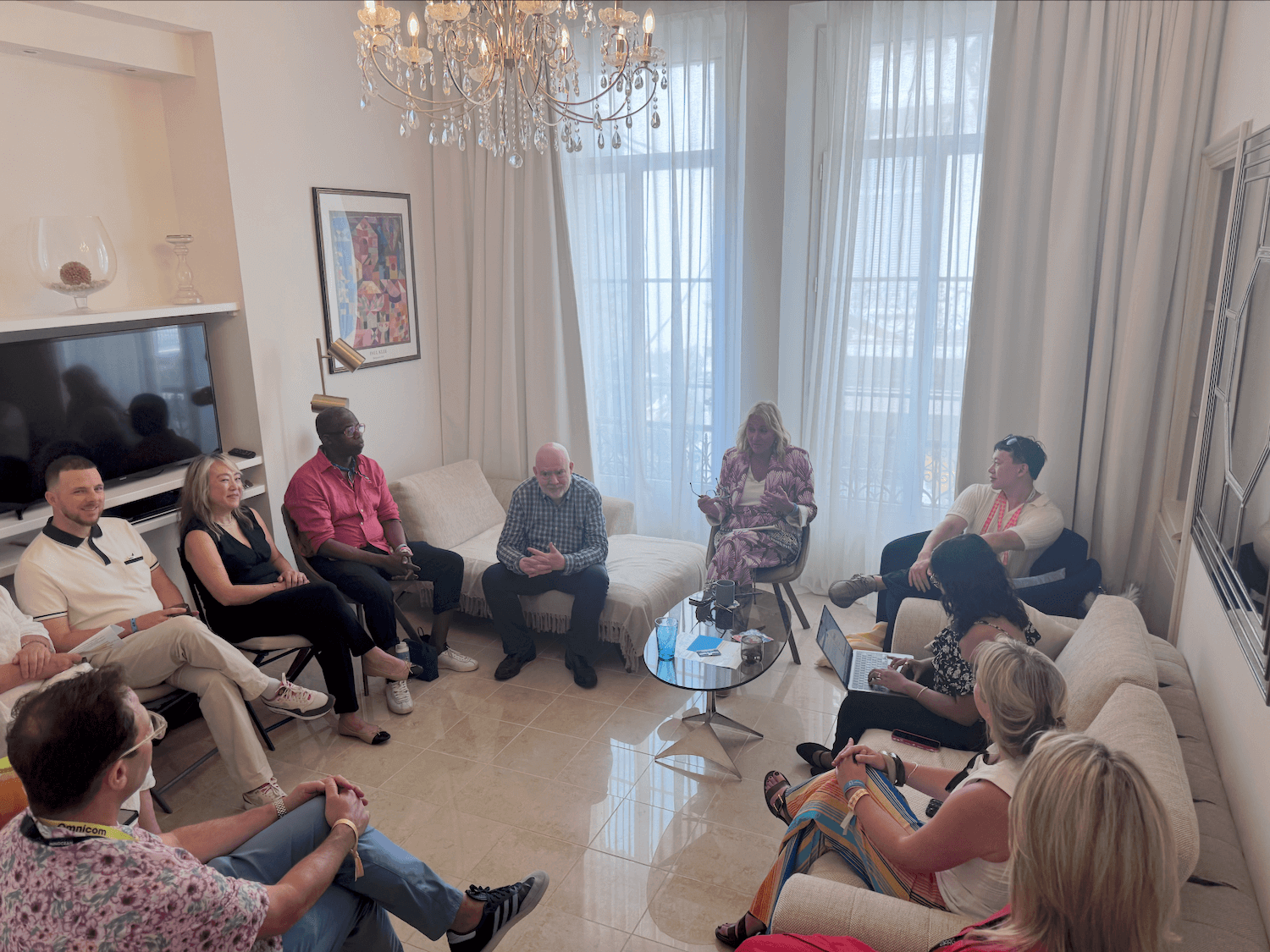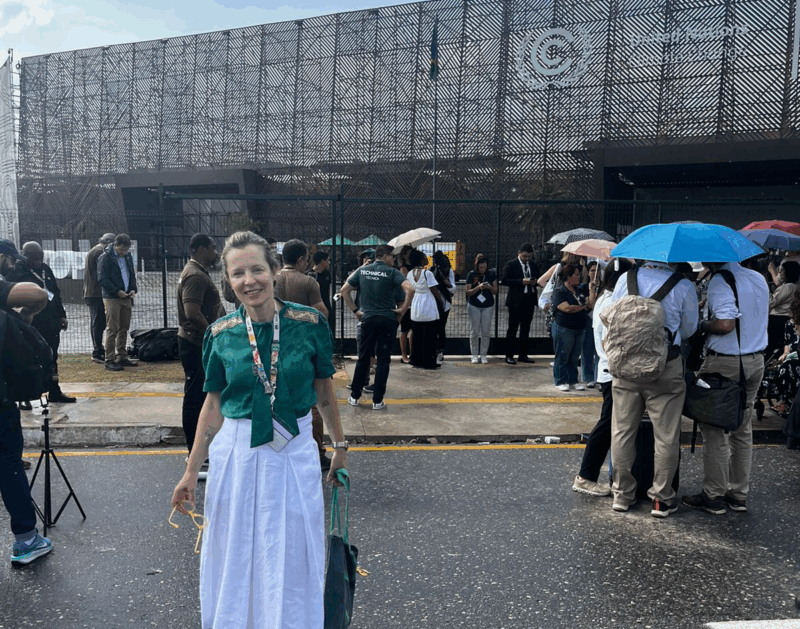
Inside the Cannes Lions Roundtable Rewriting the Future of Communication
CANNES, FRANCE (June 17, 2025) — It started with a provocation. A dozen creative renegades, strategists, technologists, and trend-spotters seated in a sunlit salon just off the Croisette, asking the question few brands dare to: If communication is broken, how do we rebuild it?
The occasion was a private roundtable on “Communication Innovation,” hosted by Porter Novelli and Provoke Media, and moderated by Porter Novelli’s Chief Innovation Officer, Sarah DaVanzo. But the topic—how to keep messaging meaningful in an AI-saturated, trust-fractured world—felt like something far more urgent. Part creative summit, part emergency summit. One thing so many diverse thinkers were in violent agreement on—communications need innovation. Now!
“Innovation in communication isn’t just about channels,” explained DaVanzo, gesturing to the brain trust of influencers, marketers, and brand futurists in the room. “It’s about reimagining communication as an ecosystem of sender, receiver, message, content, channel, context, noise, feedback—one that’s failing under new pressures.”
“We’re not just redefining channels,” said Paul Holmes, founder of Provoke Media. “We’re rewriting the fundamental assumptions of our craft.”
The subtext was clear: communications, in its traditional form, is dying. And something more intelligent, personalized, contextually adaptive, emotionally nuanced, data-informed and tech-integrated must take its place.
The Crisis of Relevance
Marketing communications are under new pressures like generative AI, which has gone from novelty to necessity almost overnight. Erin Lanuti, Chief Innovation Officer of Omnicom PR Group, didn’t mince words: “AI is no longer just a tool. It’s a stakeholder and a gatekeeper. If you’re not training large language models with your message, you’re not in the consideration set.”
That shift—from audience to algorithm— redefines how trust, attention, and even perception is built. AI engines, not consumers, now determine what content gets visibility. And brands are scrambling to catch up.
Lanuti continued: “The brand funnel has collapsed. Search traffic is dropping. And we’re seeing billion-dollar brands with just 5% visibility in AI engines. That’s not just a comms issue; it’s an existential threat.”
Language as a Weapon
If AI is the new gatekeeper, language is the new weapon. “It’s not what you say,” offered Michael Maslansky, CEO of language strategy firm Maslansky + Partners, “It’s what your audience hears. And the words we use come with baggage—especially in an era shaped by fear, surveillance, and misinformation.”
Imari Oliver, CEO of Bond & Play, pointed to the example of “smart cities”—once a promising term, now haunted by dystopian undertones of control and surveillance. The reframe? “Cognitive city.” Not just a buzzier label, but a concept rooted in responsiveness, adaptability, and human need. “‘Cognitive’ sounds alive, evolving,” Maslansky said. “It implies action. ‘Smart’ just implies you’re done learning.”
This attention to semantic nuance isn’t academic—it’s strategic. First-mover advantage in language, the group agreed, can dictate the terms of public debate. The group were aligned that language is thought, and language is communication that drives behavior, ergo language can reframe something to influence perception and behavior.
Old Media, New Power
But in a twist no one saw coming five years ago, earned media—yes, that old PR standby—is roaring back as one of the most valuable assets in the AI age.
“LLMs like ChatGPT ingest content that’s already out there,” said Katie Earlam of 72Point Group. “And 61% of what they use is earned media. That’s trust currency. That’s why we’re seeing a resurgence in long-term PR strategies.”
It’s not that owned media is dead, Earlam clarified, but it no longer guarantees influence. “Owned channels might not even get clicks anymore. But earned content lives everywhere—and more importantly, lives inside the AI.”
This feedback loop—where AI ranks trustworthiness based on earned content and earned content gains visibility through AI—creates a strange paradox: the less you control the medium, the more you may influence the message.
Five Generations, Infinite Misfires
Even within companies, communication is imploding. “For the first time in history, we have five generations working side by side,” DaVanzo noted. “Alphas, Zs, Ys, Xs, Boomers—all with radically different expectations around tone, speed, and format.”
That generational fragmentation is a design problem, not just a messaging one. “Communication styles range from asynchronous short quips on Slack with emojis to linear, structured bullet-pointed emails,” she said. “The result? A Tower of Babel inside every corporate team.”
And the outside world isn’t much better. According to Maslansky, a new study shows 70% of Americans assume they’ll be “screwed” by any company they interact with. “We’re operating in a default state of distrust,” he said.
Human-Centered Everything
So how do you rebuild communication from something broken into something human?
For Anneli Killian, founder of Cognoscenti, the answer lies in returning to first principles. “We’ve over-optimized for efficiency and under-invested in emotional resonance,” she said. “Communication must go back to trust, connection, and humanity. That’s the real innovation.”
Sylvia Park-Ekecs, Global Head of Experience at Sanofi, echoed that sentiment but framed it through design. “It’s about building for impact, access, and empathy—globally. We can’t just translate; we must transform.”
Even advanced AI applications like synthetic humans and employee-facing GenAI platforms at Sanofi, she insisted, must be built with ethical design and cultural fluency at the core.
The Influence of Play
The conversation took a surprise turn when Imari Oliver, CEO of Bond & Play, stepped in with a challenge: “Why doesn’t communication look more like gaming?”
Drawing from his experience in esports and virtual worlds, Oliver argued that the best communication mimics the best games: interactive, feedback-rich, and driven by self-interest. “In gaming, everyone wins at the first level. That’s engagement. That’s how you hook people. Why aren’t brands doing that?”
Enter the AI Storyboard
“Because they don’t know how,” said Tim Hsu, Head of BizDev at Leonardo.ai, a generative content platform acquired by Canva. “Most brands still operate like they’re producing one TV spot. Meanwhile, with GenAI, I can generate 30 storyboards in seconds. But only a human creative knows which one makes someone feel something.”
AI doesn’t replace creativity, he said. It forces a new creative standard. “Communication now means rapid prototyping and emotional precision. The bar just got higher.”
Look Sideways, Not Just Ahead
Innovation doesn’t always come from obvious places. Jonathan Brown, of Trend Hunter, reminded the group that breakthroughs often come from unexpected comparisons. “We often get too comfortable within our own industry silos,” he said. “But communication innovation, like product innovation, thrives on lateral inspiration. You might learn more about messaging from Taco Bell than from your direct competitors.”
His point: in a world where consumer expectations are shaped by every interaction—from streaming platforms to banking apps—brands must scan across industries, not just their own.
A Blueprint for What’s Next
Across the two-hour session of an eclectic group of thought-leaders who touch marketing communications, a rough blueprint emerged for where communication must go:
- Prototype communications like products
- Design communications for machines (AI) and humans simultaneously
- Use language as a framing device: new language = new behaviors
- Prioritize trust-building
- Communicators need to be technophiles as tech is media
- Approach communications, like innovation, with radical audience-centricity
- Invest in AI visibility as much as search visibility
- Return to earned media as a trust engine
Above all: communicate for relevance versus reach. The group ended with a note of optimism. “We’re in an era of massive redefinition,” Holmes said, as the session wrapped up. “Communication innovation isn’t a department. It’s a survival skill. And it’s our job, our responsibility, to challenges traditional rules and innovate and update every step of communications.”
Because if marketing communication doesn’t innovate, brands won’t just be irrelevant—they’ll be invisible.


